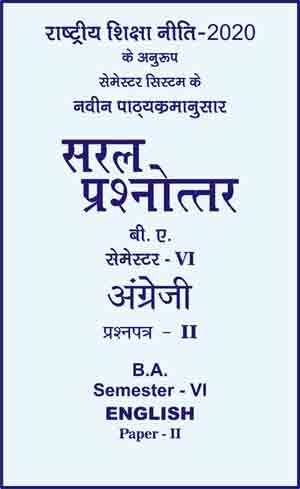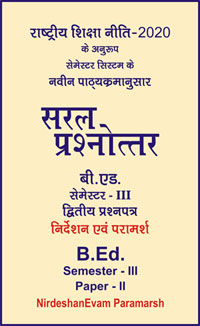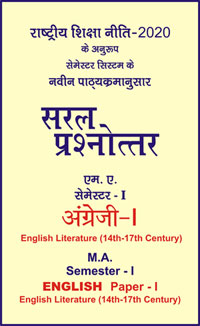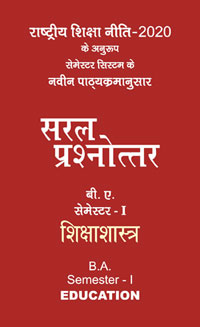|
बी ए - एम ए >> बीए सेमेस्टर 6 अंग्रेजी पेपर 2 बीए सेमेस्टर 6 अंग्रेजी पेपर 2सरल प्रश्नोत्तर समूह
|
|
||||||
बीए सेमेस्टर 6 अंग्रेजी पेपर 2
Objective Type Questions
For each of the following questions, four alternatives are given for the answer. Only one of them is correct. Choose the correct alternative.
-
In journalism, misinformation is :
(a) Deliberately created to deceive
(b) Accidentally spreading false information
(c) Reporting only verified facts
(d) Analyzing news content -
What is the primary intent of disinformation in journalism ?
(a) To entertain
(b) To report objectively
(c) To deceive or mislead
(d) To provide educational content -
A key challenge for journalists in the digital age is :
(a) Engaging with celebrities
(b) Differentiating between misinformation and accurate reporting
(c) Choosing attractive headlines
(d) Using social media -
Fact checking in journalism helps to counter :
(a) Editorial opinions
(b) Misinformation and disinformation
(c) Advertising influence
(d) Deadline pressures -
What role do social media platforms play in journalism regarding misinformation ?
(a) They eliminate all misinformation
(b) They often amplify misinformation
(c) They have no impact on misinformation
(d) They only share verified information -
The term ‘echo chamber’ in journalism refers to :
(a) A news studio
(b) Repeating verified facts
(c) Spaces where similar opinions are amplified
(d) Investigative journalism -
How can journalists combat misinformation ?
(a) By sharing popular opinions
(b) Through careful fact checking and verification
(c) Focusing on sensational stories
(d) Reporting without verification -
Media literacy is important for :
(a) Only journalists
(b) Public to discern credible news sources
(c) Entertainment purposes
(d) Social media platforms -
An example of disinformation in journalism could be :
(a) A well-researched article
(b) A report with unintentional errors
(c) Deliberately altered facts in a news report
(d) An opinion column -
‘Deep fakes’ in journalism are :
(a) In-depth investigative reports
(b) Highly realistic fake videos or audios
(c) Articles about deep-sea exploration
(d) Long interviews -
The spread of misinformation in journalism can lead to :
(a) Increased transparency
(b) Public confusion and erosion of trust
(c) Higher ratings
(d) More accurate reporting -
A journalist’s ethical responsibility includes :
(a) Prioritizing sensational news
(b) Avoiding bias and verifying information
(c) Focusing on celebrity news
(d) Reporting only government statements -
‘Yellow journalism’ is characterized by:
(a) Fact based reporting
(b) Exaggeration and sensationalism
(c) Business news
(d) Sports journalism -
In journalism, an ‘echo chamber’ effect occurs when:
(a) Reporters repeat the same news
(b) News outlets only present one viewpoint
(c) Journalists fact check their reports
(d) Different viewpoints are equally represented -
The rise of ‘fake news’ primarily challenges journalism’s:
(a) Entertainment value
(b) Economic model
(c) Credibility and public trust
(d) Article length -
Clickbait in journalism refers to:
(a) Highly informative articles
(b) Headlines designed to attract clicks, often misleading
(c) Technical aspects of online journalism
(d) Investigative reporting -
What is a primary role of a fact checker in journalism?
(a) Writing headlines
(b) Checking the accuracy of information
(c) Taking photographs
(d) Designing the layout -
Crosschecking sources in journalism is important to:
(a) Increase article length
(b) Confirm the accuracy of information
(c) Comply with government regulations
(d) Make articles more entertaining -
Propaganda in journalism is used to:
(a) Educate the public
(b) Provide balanced views
(c) Influence public opinion with biased information
(d) Report sports news -
Digital literacy for journalists involves:
(a) Learning to type fast
(b) Understanding digital content creation and verification
(c) Using social media for personal use
(d) Playing video games -
The term ‘Fourth Estate’ in journalism refers to:
(a) The government
(b) The press
(c) Online media
(d) Corporate media -
Which is a sign of credible journalism?
(a) Sensational headlines
(b) Lack of source attribution
(c) Transparency about sources and methods
(d) Frequent grammatical errors -
What challenge does ‘confirmation bias’ pose in journalism?
(a) It encourages diverse viewpoints
(b) It promotes objective reporting
(c) It leads to consuming news that aligns with personal beliefs
(d) It has no significant impact -
How has the internet impacted the spread of misinformation in journalism?
(a) It has no impact
(b) It has slowed it down
(c) It has significantly increased its spread
(d) It has made it easier to control -
Citizen journalism contributes to mainstream media by:
(a) Replacing professional journalists
(b) Providing unique, on-the-ground perspectives
(c) Always providing accurate information
(d) Focusing on celebrity news
|
|||||

 i
i 









